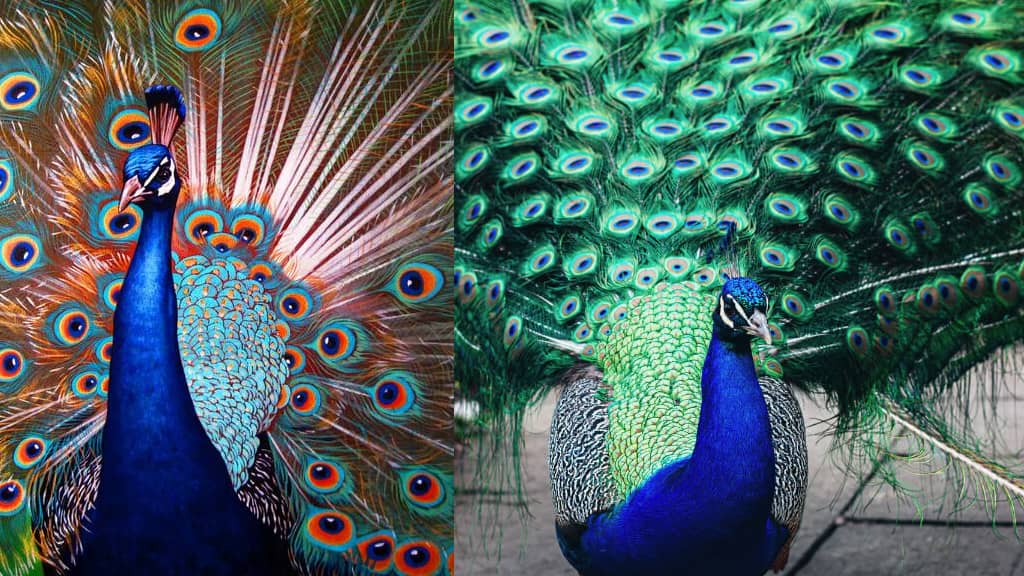
The white peacock is a magnificent bird that has captured the attention of many due to its unique and rare appearance. It is not a separate peacock species but a special peacock born all-white. The white peacock has a fascinating history, and it is associated with spiritual enlightenment, purity, grace, and renewal. In this post, we will explore the world of the white peacock, including its history, symbolism, and rarity. We will also look at some interesting facts about this superb bird of paradise. Join us as we delve into the beauty and mystery of the white peacock.
What Are White Peacocks?
White peafowls are a rare and beautiful color variation of the Indian Blue Peafowl, with blue-seeing eyes and white feathers due to a genetic mutation called leucism. These birds are either leucistic or albino peafowl, with albino peafowl having red eyes and pale skin. White peafowl are highly prized for their unique appearance and historically symbolize purity, eternity, and unconditional love. They are not a separate species of peafowl but are selectively bred in captivity.
History of white peacock

White peacocks, native to India, were introduced to Europe and America by the British Empire after their conquest. The first known white color variation appeared in 1830, and they are now bred for this color in captivity. Peacocks were once a delicacy, displayed on plates for guests, but their meat is not very tender. The first known white color variation in peacocks is unknown, but it is now a common sight in captivity.
Nesting Habits
White peafowl chicks are born yellow with white wings and become entirely white as they mature. White peacocks are bred to white peahens, resulting in a variety of colors in their chicks. The clutch of a peahen is 3 to 6 eggs, and chicks can only fly short distances after 3 days. Peafowls are omnivores, eating plant parts, insects, flower petals, seed heads, and amphibians.
The male is referred to as a peacock, while the females are called peahens. Peachicks are baby peafowls with brown, gray, or cream plumage feathers and white bellies. Males are larger, measuring three to four and a half feet long and weighing nine to thirteen pounds, while peahens are two and a half to three and a half feet long and weigh six to nine pounds.
Evolutionary advantages of white peacock
The male peafowl, including white peacocks, have evolved numerous advantages to survive and reproduce. These include elaborate courtship displays, predator avoidance strategies, thermoregulation, and complex social dynamics. Female peafowls prefer males with longer and more elaborate trains, leading to larger and more colorful tails. Thermoregulation is crucial for maintaining body temperature, and feathers play a crucial role in this process. Peafowls live in groups, and males have evolved territorial behavior to protect their mates and offspring.
Related: How fast is a Cheetah mph Top Speed?
Rarity of white peacocks

How rare are white peacocks? White peacocks are incredibly rare, and their coloring is caused by a unique genetic mutation called leucism, which inhibits melanin from being deposited into their feathers. Leucism is a recessive condition, which means it can be carried but hidden beneath the dominant gene that produces the normal blue coloration of Indian Blue Peafowl. White peafowl are either leucistic or albino peafowl, with albino peafowl being even rarer than leucistic peafowl. While leucistic white peacocks are far more common than albino peacocks, both types are incredibly rare.
Most white peafowl belong to the Indian peacock species, and they are usually bred for their unique coloration in captivity. White peafowl are highly prized for their unique appearance and have historically symbolized purity, eternity, and unconditional love. However, white peafowl do not get any evolutionary advantages from their lack of pigmentation, and they would probably stand out more in their natural environment.
What Are Typical Peacock Colors?

Courtship displays are a significant aspect of peacocks, with the Indian peahen, Congo peafowl, and Javanese peafowl all displaying unique colors and genetic mutations. The Indian peahen, with its flashy blue head and neck, is a recognizable species, while the Congo peafowl has deep blue feathers with a metallic green and violet tinge. These feathers are used to attract mates during these displays.
What are the different types of peacock feathers?
There are different types of peacock feathers, each with distinctive features. Here are some of the different types of peacock feathers:
The white peacock is a unique species with various types of feathers, including ocelli, upper tail coverts, flaplumes, and curve feathers. The ocelli, a central dark spot, is surrounded by vibrant colors. The upper tail coverts are marked with eyespots and are used during courtship displays. Filoplumes are sensory feathers on the head and neck, while curve feathers are specialized structures in male peafowl tails. Wing-barring feathers, ranging from 2 inches to 16 inches, are limited in quantity. Flight feathers, used for flight, are available for various purposes, including hair accessories and home decor.
How Much is a White Peacock Worth?
White peacocks, a rare and highly sought-after breed, are primarily found in captivity, where they are selectively bred to pass on their unique traits. These peacocks, a color variation of the Indian Blue Peafowl, are primarily found in captivity, where they are primarily admired for their purity, eternity, and unconditional love. The cost of white peacocks can vary depending on breeder, location, and availability.
White Peafowl Have a Genetic Mutation
White peafowl, a rare breed of peacock, are characterized by their unique appearance due to a genetic mutation called leucism. This condition causes the feathers to turn pale or white, affecting their leucistic or albino status. The white feathers on a peacock depend on dominant and recessive genes. White peafowl are primarily found in captivity, where they are selectively bred to pass on their traits.
Difference between leucism and albinism in peacocks
Leucism is a genetic condition that causes a partial loss of pigmentation, while albinism is a specific condition that causes a complete lack of melanin, which gives skin, feathers, hair, and eyes their color. In peafowl, white peafowl are most often leucistic, not albino, and are born with a genetic condition that strips them—or parts of them—of pigment. Leucistic peafowl will have partially white or patchy features with darker eyes, while albino peafowl have red eyes and extremely pale skin. White peafowl carry a genetic mutation called leucism, which inhibits melanin from being deposited in their feathers. They are highly prized for their unique appearance and are primarily found in captivity, where they are selectively bred to pass on their traits and make more white peafowl.
what is it called when a peacock spreads its feathers
A peacock’s courtship display involves spreading its vibrant colors and patterns, signaling its health and strength to potential mates. The peacock’s long, colorful tail feathers, marked with eyespots, are particularly noticeable during this display. The peacock also makes a rattling sound by shaking its feathers, adding to the display and attracting the attention of peahens. Overall, the white peacock’s display is a powerful tool for attracting potential mates.
where are white peacocks found
White peacocks are a rare and unique color variation of the Indian Blue Peafowl, bred for their white coloring. They are found worldwide and are the first recognized color mutation. White peafowl are not a separate breed but are primarily found in captivity, where they are selectively bred to pass on their traits. While some white peafowl can be found in the wild, they are more common in captivity, where they can live for up to 50 years.
How rare is a white peacock
White peacocks are rare and unique color variations of the Indian Blue Peafowl. Here are some key points about how rare white peacocks are:
White peacocks are a rare and sought-after color variation of the Indian Blue Peafowl, with leucistic white peacocks being more common than albino peacocks. These rare species are not a separate breed of peafowl but are selectively bred in captivity. White peafowl were the first recognized color mutation and can be found in India. The genetic condition of leucism is rare, and only a few thousand of these white peafowl may exist. The IUCN lists white peafowl as a species of “least concern.”
white peacock spiritual meaning
White peacocks, often depicted in Christian artwork, hold significant spiritual symbolism, representing enlightenment, purity, grace, renewal, victory, immortality, and knowledge. They are also associated with Jesus Christ, symbolizing death, resurrection, eternal life, and spiritual awakening. These white peacocks serve as divine messengers in spiritual practices, delivering messages of abundance and blessings.
white peacock spiritual meaning
White peacocks, often depicted in Christian artwork, hold significant spiritual symbolism, representing enlightenment, purity, grace, renewal, victory, immortality, and knowledge. They are also associated with Jesus Christ, symbolizing death, resurrection, eternal life, and spiritual awakening. These white peacocks serve as divine messengers in spiritual practices, delivering messages of abundance and blessings.
Conclusion:
The white peacock is a rare and unique color variation of the Indian Blue Peafowl that has captured the attention of many due to its stunning appearance. It is not a separate species of peacock but rather a special peacock that has been born all white. The white peacock has a fascinating history, and it is associated with spiritual enlightenment, purity, grace, and renewal. The majority of white peafowl exist in captivity, where they are selectively bred to pass on their traits and make more white peafowl. While leucistic white peacocks are more common than albino peacocks, both types are incredibly rare. The white peacock is a symbol of beauty, grace, and spiritual enlightenment, and it continues to captivate people all over the world.
Reference
The white peacock is a magnificent bird of paradise that has captured the attention of many due to its unique and rare appearance. It is not a separate species of peacock but rather a special peacock that has been born all white. The white peacock has a fascinating history, and it is associated with spiritual enlightenment, purity, grace, and renewal.
The white peacock is also associated with victory, immortality, and knowledge in the spiritual realm. The majority of white peacocks exist in captivity, where they are selectively bred to pass on their traits and make more white peafowl. While leucistic white peacocks are more common than albino peacocks, both types are incredibly rare. The white peacock is a symbol of beauty, grace, and spiritual enlightenment, and it continues to captivate people all over the world.
Sources: https://randomfunfactsonline.com/white-peacocks-facts/


